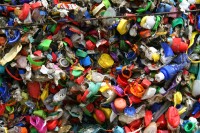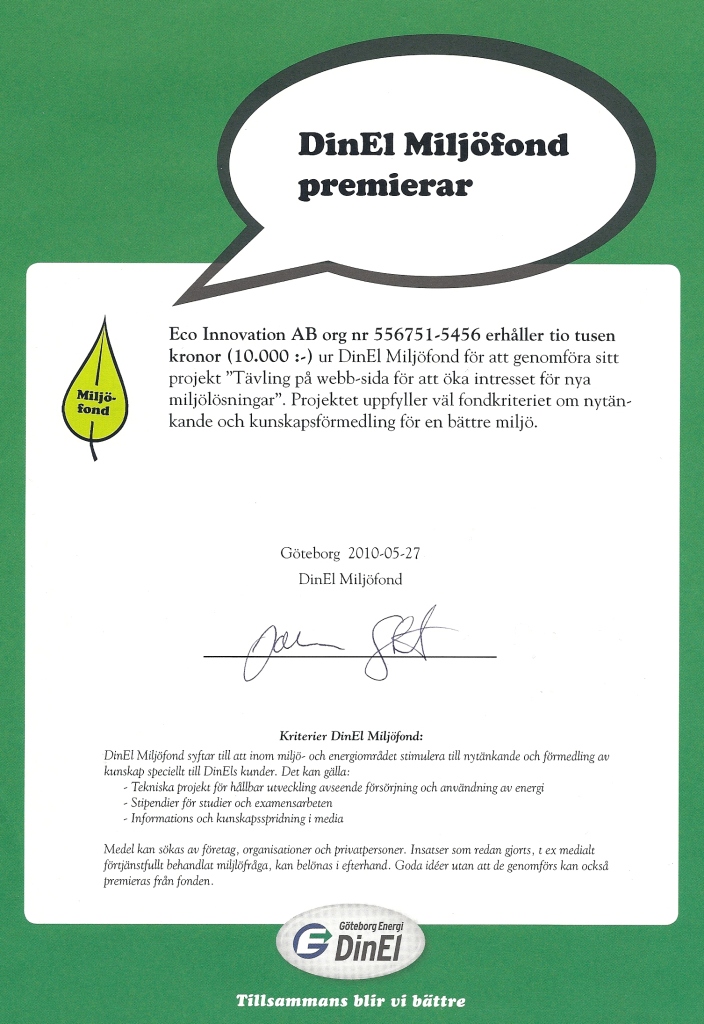 Kärnan i EU:s satsning för miljöinnovationer och miljöteknik är Aktionsplanen för Miljöteknik (ETAP, Environmetal Technologies Action Plan). Mycket av förutsättningar för utveckling bestäms på EU-nivå. Här är några utdrag ur senaste Nyhetsbrevet om:
Kärnan i EU:s satsning för miljöinnovationer och miljöteknik är Aktionsplanen för Miljöteknik (ETAP, Environmetal Technologies Action Plan). Mycket av förutsättningar för utveckling bestäms på EU-nivå. Här är några utdrag ur senaste Nyhetsbrevet om:
- Mätning av miljöinnovation
- Nätverk för observation av Eco Innovation
- Solar Europe Industrial Initiative
- Multidune hydralic separator som ska kunna sortera plaster.
Europe Innova Sectoral Innovation Watch anser i en rapport att man behöver intensifiera arbetet för att utveckla metoder att mäta eco- innovation. Svårigheterna är legio. I värsta fall finns här pengar för resultatlös forksning i 10 år (Min kommentar). Ett grundproblem är förstås att indikatorer för innovationer och för miljö är så väsensskilda. Några förslag är att:
- Ta fram nya metoder för att sammanställa informaiton om produkter och processer.
- Skapa en integrerad databas på EU-nivå.
Vill Du veta mer så kolla http://ec.europa.eu/environment/etap/inaction/policynews/259_en.html
Kommissionen har lagt ut ett call förr att bilda ett nätverk för observation av Eco-Innovation. Det ska bilda en strategisk kunskapsbas utifrån erfarenheterna av bland annat Ramprogrammet för Konkurrenskraft och Innovation. Läs mer: http://ec.europa.eu/environment/etap/inaction/policynews/260_en.html
Kommissionären Potocnik har efterlyst ett ”Solar Europe Industrial Initiative to accelerate technical progress”. Det skulle ha flera mål:
”Such an initiative would incorporate the European Photovoltaic Technology Platform’s goal of reaching grid parity in most of Europe by 2020. The SEI initiative will have to achieve a number of objectives:
- Aligning technology development with energy policy goals;
- Developing and maintaining strategic technology alliances, such as the relationship between the PV Technology Platform and ETAP;
- Strengthening European energy research capacities;
- Further development of Trans-European energy networks;
- Implementation of transition planning; and
- Increasing financial and human resources”
Läs mer här: http://ec.europa.eu/environment/etap/inaction/policynews/261_en.html
The recycling of plastics has been hampered in the past by sorting difficulties, but with the advent of the Multidune hydraulic separator, a solution may have finally been found.
Conservation of resources, energy concerns and over-reliance on landfill have increased the need for better plastics recycling. A recent innovation developed by Italian researchers could solve the taxing problem of sorting plastics of similar size and density, and so provide a means to improve recycling.
Plastics recycling has traditionally proven difficult as many types of plastic, each with different physical and chemical properties, may have very similar masses. In the past, recycling techniques focused on separating particles according to their physical characteristics, mass (weight), size or chemical properties. These processes are usually carried out on single types or mixtures of plastics after a selective collection.
Any of the established methods of industrial separation may be implemented in the recycling plant – for example, automatic sorting, electrostatic separation, gravity separation or flotation. However, all are prone to the same problems and difficulties regarding separating plastics that have a similar mass. For this reason, the recycling of plastics has needed a precise technology to sort plastics according to their exact individual mass.
The Multidune Separator contains a series of parallel semi-cylindrical transparent tubes. It has been specifically designed to pinpoint even the smallest differences in mass between plastic particles. This enables it to address the problem of separating plastic particles of a similar mass. Its high sensitivity allows the instrument to recognise plastic particles of an extremely small specific mass (1g/cm³). It functions by transporting a mixture of plastic particles and fluid through a network of pipes, using fluid dynamics to separate the plastics into outlets that correspond to their particular density.”


